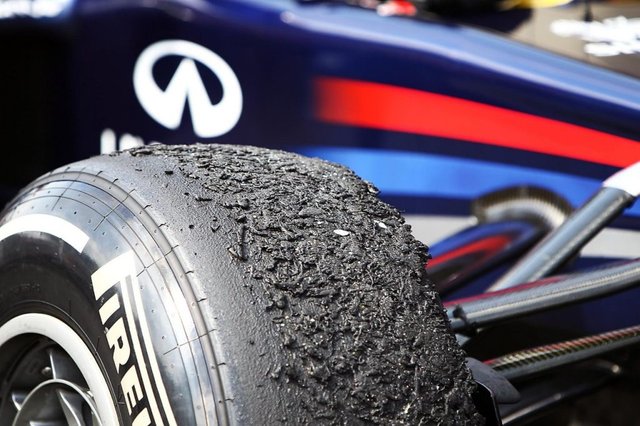Formula 1 Basics - Tyres
In the days of old, a number of manufactures supplied different teams with different tyres. In the modern era, Pirelli provides all teams with identical rubber. There are 5 specifications of dry tyres and 2 specifications of wet tyres.
Dry Weather
In dry weather, Pirelli nominates 2 tyre types that are mandatory for each race, depending on the characteristics of the track. Circuits with long, high speed apexes require a much more durable compound to last the race distance. In order for drivers to fill the 2 compound quota, a minimum of 1 pit stop is needed.
Dry weather tyres are also known as slicks due to their smooth surface.
| Name | Color | Tread | Grip | Durability |
|---|---|---|---|---|
| Hard | Orange | Slick | 1 - Least Grip | 5 - Most Durable |
| Medium | White | Slick | 2 | 4 |
| Soft | Yellow | Slick | 3 | 3 |
| Supersoft | Red | Slick | 4 | 2 |
| Ultrasoft | Purple | Slick | 5 - Most Grip | 1 - Least Durable |
Wet Weather
Wet weather tyres are designed to displace as much water as possible. This is to avoid aquaplaning, where the car loses traction due to a pool of water separating the tyre and track surface. Aquaplaning is the cause of many wet weather incidents.
| Name | Color | Tread | Conditions |
|---|---|---|---|
| Intermediate | Green | Treaded | Light standing water |
| Wets | Blue | Treaded | Heavy standing water |

Undercutting
The best way to understand the importance of tyres is to understand the strategy called 'undercutting'. The idea of undercutting is to make a pit stop a few laps before the car you are trying to catch. After the stop, with a new and possibly higher grip compound, you can expect to set much quicker lap times than the car with older, more worn tyres. When your opponent completes his pit stop a few laps later, you will have hopefully gained enough time to come out ahead.

Tyre Management
Tyre management can create an interesting dynamic in a race that may appear to be quite dull. The compounds require huge levels of heat to run at maximum efficiency and this can cause problems. On the circuits with hotter track surfaces, tyre blisters are a factor. This is where the compound begins to break down, bubble and pieces may detach. Drivers who find themselves with severely degraded tyres - before they have reached strategy targets - may have an undesired pit stop in their race.

Leave your comments down below and be sure to follow @poleposition for more F1 news, guides and analysis.
Congratulations @poleposition! You have completed some achievement on Steemit and have been rewarded with new badge(s) :
Click on any badge to view your own Board of Honor on SteemitBoard.
For more information about SteemitBoard, click here
If you no longer want to receive notifications, reply to this comment with the word
STOPCongratulations @poleposition! You have completed some achievement on Steemit and have been rewarded with new badge(s) :
Click on any badge to view your own Board of Honor on SteemitBoard.
For more information about SteemitBoard, click here
If you no longer want to receive notifications, reply to this comment with the word
STOPCongratulations @poleposition! You have received a personal award!
Click on the badge to view your Board of Honor.
Do not miss the last post from @steemitboard:
Congratulations @poleposition! You received a personal award!
You can view your badges on your Steem Board and compare to others on the Steem Ranking
Do not miss the last post from @steemitboard:
Vote for @Steemitboard as a witness to get one more award and increased upvotes!